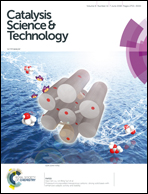Hydrogen-bonding-assisted charge transfer: significantly enhanced photocatalytic H2 evolution over g-C3N4 anchored with ferrocene-based hole relay†
Abstract
Herein, a polymeric graphitic carbon nitride (for simplicity, g-C3N4) photocatalyst has been identified as a promising material for hydrogen production from water due to its comparatively low cost and facile modification of its electronic structure. However, to date, how to speed up the transfer rate of photogenerated charges, especially hole transfer rate, still remains a formidable challenge. Herein, a novel system of g-C3N4/1,1′-ferrocenedicarboxylic acid (FcDA) composites was developed for efficient visible light-driven H2 evolution, in which the redox mediator FcDA served as hole-transport molecules and platinum (Pt) acted as an electron sink. The FcDA molecules are anchored onto g-C3N4 by hydrogen-bonding interactions between the carboxylic groups and amino groups as well as π–π interactions between aromatic FcDA and graphitic C3N4. The matched energy-levels between g-C3N4 and FcDA facilitate photogenerated hole transfer from the g-C3N4 valence band to FcDA that results in the formation of FcDA+ radicals, and thus, photoinduced electrons and holes are efficiently separated. Due to the additional charge separation pathway, enhanced hole transfer kinetics, and the extremely rapid intermolecular radical reactions, charge recombination is effectively suppressed; therefore, more electrons can be released for hydrogen production. Under optimal experimental conditions, the developed g-C3N4/FcDA composite with 4 wt% FcDA exhibits high water splitting activity with a H2 evolution rate of up to 77.91 μmol h−1, which is nearly 6 times that of bare g-C3N4 (13.18 μmol h−1). Moreover, the obtained g-C3N4/FcDA photocatalyst displays excellent stability, and there is no obvious decrease in the H2-production rate after five test cycles. Thus, we anticipate that our simple modification strategy will offer an avenue to merge the polymeric g-C3N4 photocatalyst with surface organometallic chemistry for high-efficiency solar-to-fuel conversion.



 Please wait while we load your content...
Please wait while we load your content...